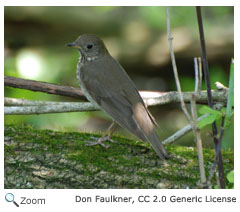Gray-cheeked Thrush -Catharus minimus |
|||||||||||
Description
RangeThe Gray-cheeked Thrush is migratory. In the summer, it lives across Alaska and the northern part of Canada. During the winter, the Gray-cheeked Thrush migrates to the northern part of South America including Colombia , Venezuela, Peru and Brazil. HabitatThe Gray-cheeked Thrush spends the summer in areas made up of small shrubs with a dense understory. It lives in habitats that border the tundra. The Gray-cheeked Thrush winters in the understory of tropical forests. |
DietAn omnivore, the Gray-cheeked Thrush eats mostly insects like beetles, weevils, ants, wasps and caterpillars. It may eat spiders, crayfish, sow bugs and earthworms. In addition, the Gray-cheeked Thrush eats grapes, wild cherries, blackberries, raspberries and other fruit. Life CycleThe female builds the nest out of dried grasses mixed with mud. The addition of mud makes the nest stronger. She lays 3-5 light greenish-blue eggs and incubates them for about two weeks. Right after hatching, the young chicks cannot feed themselves and depend on their parents for food. The Gray-cheeked Thrush typically has one brood per season. Sometimes, it will lay a second brood if the first one fails to survive. BehaviorWhen the Gray-cheeked Thrush eats fruit, it fails to full digest the seeds. During its travels, it spreads the seeds, helping fruit propagate in new areas. |
||||||||||
Audio Credit: xeno-canto.org Paul Driver |
|||||||||||

